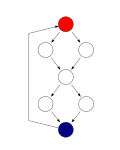In computer science, hyperproperties are a formalism for describing properties of computational systems. Hyperproperties generalize safety and liveness properties, and can express properties such as non-interference and observational determinism.
Elaborating on the example of non-interference: Non-interference can't be represented as a "property" in the formal sense because there's no inclusion-test that could be applied to a single program trace; non-interference is an assertion about how neighboring traces are similar to each other and it does no good to look at one trace at a time. "Hyperproperties" are the extension from properties as predicates on traces to properties as relations between traces.
Definitions
Traces and systems
Hyperproperties are defined in terms of traces of a computational system. A trace is a sequence of states; a system is a set of traces. Intuitively, a program corresponds to the set of all of its possible execution traces, given any inputs. Formally, the set of traces over a set of states is .
This representation is expressive enough to encompass several computational models, including labeled transition systems and state machines.
Hyperproperties
A trace property is a set of traces. Safety and liveness properties are trace properties. Formally, a trace property is an element of , where is the powerset operator. A hyperproperty is a set of trace properties, that is, an element of .
Trace properties may be divided into safety properties (intuitively, properties that ensure "bad things don't happen") and liveness properties ("good things do happen"), and every trace property is the intersection of a safety property and a liveness property. Analogously, hyperproperties may be divided into hypersafety and hyperliveness hyperproperties, and every hyperproperty is an intersection of a safety hyperproperty and a liveness hyperproperty.
-safety properties are safety hyperproperties such that every violation of the property can be witnessed by a set of at most traces.
Examples
- Every safety property can be lifted to a 1-safety hyperproperty that expresses the same condition.
- -safety hyperproperties:
- (lifts of safety properties):
- false, defined to be the set containing the empty set. Formally, . This hyperproperty is not satisfied by any system.
- true, defined to be the set of all traces. Formally, . This hyperproperty is satisfied by all systems.
- Access control
- :
- Monotonicity
- Injectivity
- Symmetry, anti-symmetry, and asymmetry
- Observational determinism
- Noninterference
- (lifts of safety properties):
Properties
Since hyperproperties are exactly the elements of the power set , they are closed under intersection and union.
The lower Vietoris topology of a standard topology on trace properties yields a topology on the set of hyperproperties.
Applications
Several program logics have been developed for checking that a program conforms to a hyperproperty.
HyperLTL and some model checking algorithms have been developed for checking that a finite state system conforms to a hyperproperty.
References
Notes
- Clarkson & Schneider 2010, p. 1.
- Clarkson & Schneider 2010, p. 23: "A labeled transition system can be encoded as a set of traces.".
- Clarkson & Schneider 2010, p. 25: "A state machine M can be encoded as a set of traces.".
- Alpern, Bowen; Schneider, Fred B. (1985-10-07). "Defining liveness". Information Processing Letters. 21 (4): 181–185. doi:10.1016/0020-0190(85)90056-0. ISSN 0020-0190.
- Clarkson & Schneider 2010, p. 21.
- Finkbeiner, Bernd; Haas, Lennart; Torfah, Hazem (June 2019). "Canonical Representations of k-Safety Hyperproperties". 2019 IEEE 32nd Computer Security Foundations Symposium (CSF). pp. 17–1714. doi:10.1109/CSF.2019.00009. ISBN 978-1-7281-1407-1. S2CID 201848133.
- Clarkson & Schneider 2010, p. 11: "Safety properties lift to safety hyperproperties".
- Clarkson & Schneider 2010, p. 15: "The hyperproperty false, defined as \{\emptyset\}, is hypersafety but not hyperliveness"..
- Clarkson & Schneider 2010, p. 44.
- Clarkson & Schneider 2010.
- ^ Sousa & Dillig 2016.
- Clarkson & Schneider 2010, p. 13: "observational determinism OD (2.6) cannot be expressed as a 2-safety property, but it is a 2-safety hyperproperty".
- Clarkson & Schneider 2010, p. 19.
- ^ D'Osualdo; Farzan; Dreyer (2022). "Proving hypersafety compositionally". Proceedings of the ACM on Programming Languages. 6 (OOPSLA2): 289–314. arXiv:2209.07448. doi:10.1145/3563298. S2CID 252284134.
- Dardinier, Thibault; Müller, Peter (2023-01-24). "Hyper Hoare Logic: (Dis-)Proving Program Hyperproperties (extended version)". arXiv:2301.10037 .
- Finkbeiner, Bernd; Rabe, Markus N.; Sánchez, César (2015). "Algorithms for Model Checking HyperLTL and HyperCTL $$^*$$". In Kroening, Daniel; Păsăreanu, Corina S. (eds.). Computer Aided Verification. Lecture Notes in Computer Science. Vol. 9206. Cham: Springer International Publishing. pp. 30–48. doi:10.1007/978-3-319-21690-4_3. ISBN 978-3-319-21690-4.
- Hsu, Tzu-Han; Sánchez, César; Bonakdarpour, Borzoo (2021). "Bounded Model Checking for Hyperproperties". In Groote, Jan Friso; Larsen, Kim Guldstrand (eds.). Tools and Algorithms for the Construction and Analysis of Systems. Lecture Notes in Computer Science. Vol. 12651. Cham: Springer International Publishing. pp. 94–112. doi:10.1007/978-3-030-72016-2_6. ISBN 978-3-030-72016-2. PMC 7979203.
Sources
- Clarkson, Michael R.; Schneider, Fred B. (2010-09-20). Sabelfeld, Andrei (ed.). "Hyperproperties". Journal of Computer Security. 18 (6): 1157–1210. doi:10.3233/JCS-2009-0393. S2CID 218604768.
- Sousa, Marcelo; Dillig, Isil (2016-06-02). "Cartesian hoare logic for verifying k-safety properties". Proceedings of the 37th ACM SIGPLAN Conference on Programming Language Design and Implementation. PLDI '16. New York, NY, USA: Association for Computing Machinery. pp. 57–69. doi:10.1145/2908080.2908092. ISBN 978-1-4503-4261-2. S2CID 17433405.
| Program analysis | |||||||||||||||
|---|---|---|---|---|---|---|---|---|---|---|---|---|---|---|---|
| Key concepts |  | ||||||||||||||
| Semantics |
| ||||||||||||||
| Analyses |
| ||||||||||||||
| Formal methods |
| ||||||||||||||
 is
is  .
.
 , where
, where  is the
is the  .
.
 -safety properties are safety hyperproperties such that every violation of the property can be witnessed by a set of at most
-safety properties are safety hyperproperties such that every violation of the property can be witnessed by a set of at most  (lifts of safety properties):
(lifts of safety properties):
 . This hyperproperty is not satisfied by any system.
. This hyperproperty is not satisfied by any system. . This hyperproperty is satisfied by all systems.
. This hyperproperty is satisfied by all systems. :
:

